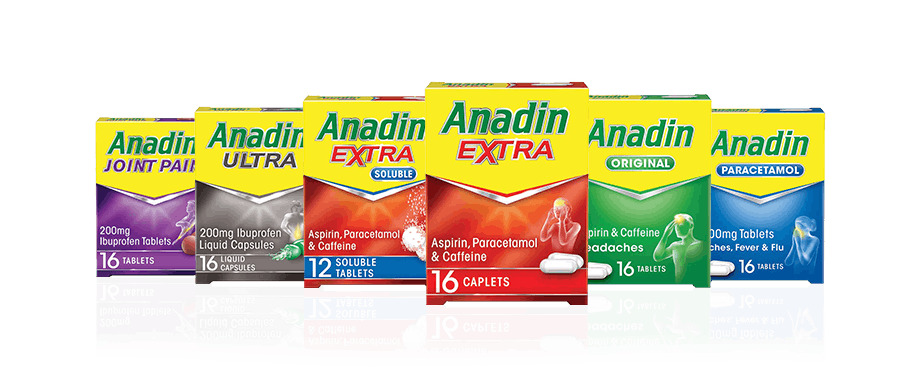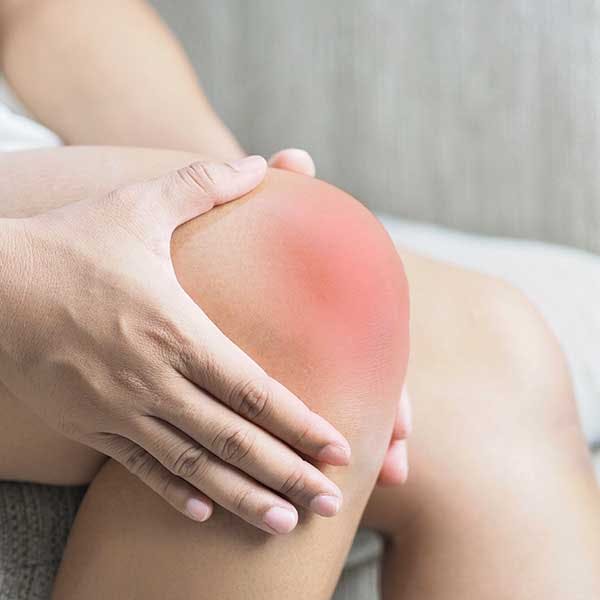Aspirin + Caffeine
Aspirin + Paracetamol + Caffeine
Anadin Extra Tablets Anadin Extra Soluble Tablets
Paracetamol
Wrist pain can interfere with your daily activities, and may prevent you from doing things like driving, lifting, typing, and much more. Find out how to relieve wrist pain below.
Common Causes of Wrist Pain
There are many reasons your wrist might hurt, including:
Wrist Sprain
A sprain is a torn or twisted ligament (tissue that connects the joints), common in the wrist. A sprained wrist may be painful, swollen and bruised. You might find it difficult to use your wrist normally or experience cramping. This can usually be treated with rest, ice, compression (wrap a bandage round for support), elevation as much as possible and paracetamol.
Carpal Tunnel Syndrome
Carpal tunnel syndrome is when a nerve in your wrist is pressurised, causing numbness, tingling and pain in the hand and fingers. Symptoms can be worse at night. It can be treated at home with pain medicine, a wrist splint and rest, but more severe cases can require surgery. Always speak to a healthcare professional if you are concerned.
Wrist Tendonitis
Tendonitis is caused by a swollen tendon after a tendon injury. It can cause stiffness and pain in the wrist, and difficulty moving your hands and fingers. Mild tendon injuries can be treated at home with painkillers such as paracetamol or ibuprofen, rest, ice and support (wrapping a bandage or brace round the area and take off before bed). Tendonitis should heal within 2 to 3 weeks. Try to avoid heavy lifting, twisting actions or playing sports until healed to prevent further injury. If your symptoms do not improve within a few weeks or you are in severe pain, please consult a healthcare professional.
Arthritis
A painful wrist joint might be a sign of arthritis, which causes inflammation and joint pain. There are several types of arthritis, the most common being osteoarthritis and rheumatoid arthritis. Osteoarthritis affects the cartilage lining of the joint, which begins to roughen and thin out, making movement more difficult and causes pain and stiffness. Rheumatoid arthritis is less common than osteoarthritis and is caused by the body’s immune system targeting affected joints, resulting in pain, swelling and a break down of cartilage. Arthritis is chronic and cannot be cured, but pain medication, physiotherapy and sometimes surgery can help alleviate pain for sufferers.
Broken Wrist
If you’ve had an injury, like a fall, that has caused sharp sudden wrist pain and swelling, it may be broken. Seek attention from a healthcare professional if you suspect you have broken your wrist.
If you’re concerned about wrist pain that has lasted for over 2-3 weeks despite pain medication and rest, please see a healthcare professional for examination
Treatments for Wrist Pain
Anadin pain relief products:
- For temporary pain relief for conditions like wrist pain, Anadin Joint Pain Tablets contain ibuprofen to relieve pain, swelling and inflammation in the wrist joint.
- Do not take medicines containing ibuprofen for new injuries that are less than 2 days old.
- For new injuries, take Anadin Paracetamol Tablets for pain relief.
- Talk to a healthcare professional if you’re not sure what type of pain relief you need
Rest:
Try to rest your wrist as much as possible, avoiding exercise, activities and putting any weight on the injury. When you can move the injury without pain preventing you, try to keep moving it to prevent stiffness.
Ice
Use an ice pack or a bag of frozen vegetables wrapped in a tea towel to the injury for up to 20 minutes every 2 to 3 hours. Try to avoid heat (such as hot baths and heat packs) for first couple of days to prevent swelling.
Compression
Wrap a bandage around the injury to support it.
Elevate
Keep the injury raised on a pillow as much as possible.
If you think you have broken your wrist, then see a healthcare professional as soon as possible. Depending on the extent of the injury, you may be given a sling or cast to support it or receive surgery.
Wrist Pain Exercises
Gentle wrist exercises can help you manage pain and relieve stiffness in your wrist, enabling you to get movement back. However, a healthcare professional will be able to advise on whether these exercises are suitable for managing your pain. Suggested wrist exercises include:
1. Fist Clench
Rest the side of your hand on a table, with your fingers and wrist straight. Then, slowly clench your hand into a loose fist. Hold this for 2 seconds, then gently stretch out your fingers again.
2. Wrist Bend
Rest your hand on the table, in a loose fist on its side. Gradually bend your wrist and hand up towards you. Hold for 2 seconds, then bend away from your clenched hand away from your body. Now hold this for 2 seconds again before returning to the starting position.
3. Flexed Hand Clench
Start with your hand in a loose fist resting sideways on the table. Next, tilt your wrist and hand so that your thumb is parallel with your body. Only tilt as far as is comfortable before returning to the starting position.
4. Finger and Thumb Touches
Rest the side of your wrist on a flat table. With your hand in front of you, spread your fingers out straight. Next, touch the tip of your thumb to the tip of your little finger, then stretch out your hand again.
Wrist Pain FAQs
What is the difference between carpal tunnel syndrome and arthritis?
Arthritis affects the joint, bones, and cartilage in the wrist, whereas carpal tunnel syndrome is when the main nerve in your hand becomes compressed. There are different types of arthritis, the most common osteoarthritis which causes pain and stiffness resulting from the roughening and thinning out of the cartilage lining of the joint. Rheumatoid arthritis is also common but is instead caused by the body’s immune system targeting the affected joints which results in pain, swelling and a breakdown of cartilage.
Carpal tunnel syndrome can cause tingling, numbness, and pain in your hand and fingers, not associated with arthritis. Common symptoms of arthritis include joint pain, tenderness, stiffness, inflammation, weakness, and restricted movement of the joints.
However, the symptoms vary depending on which type you have so if you think you may have arthritis, consult a healthcare professional.
If you have swelling and pain in the hand and wrist area, see a healthcare professional who can diagnose the issue.
What is the difference between carpal tunnel syndrome and tendonitis?
Carpel tunnel syndrome is likely to cause numbness, tingling and “pins and needles” sensations in the hand and fingers, whereas tendonitis in the wrist will present as a painful wrist joint and stiffness.
See a healthcare professional if you’re unsure what is causing your wrist pain.
What does tendonitis feel like in the wrist?
Symptoms of wrist tendonitis can include wrist pain that gets worse with movement, difficulty moving the joint, a grating or crackling sensation during movement of the wrist tendon and swelling which could sometimes be with heat or redness.
See a healthcare professional if you are in sudden and/or severe pain, or if your symptoms do not improve within a few weeks.













